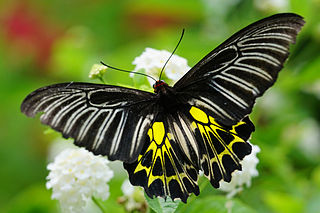
Papilio alcmenor, the redbreast, is a species of swallowtail butterfly found in South Asia.

Byasa nevilli, the Nevill's windmill, is a butterfly found in India that belongs to the windmills genus (Byasa), comprising tailed black swallowtail butterflies with white spots and red submarginal crescents.

Papilio castor, the common raven, is a species of swallowtail butterfly found in Cambodia and South Asia.

Papilio polyctor, the common peacock or indian peacock or mahaonovaya indian butterfly with emerald- is a swallowtail butterfly found in the Indian subcontinent. It is found in the Himalayas and parts of India from the foothills to 7,000 feet (2,100 m) between March and October. It has distinct dry- and wet-season forms. The butterfly frequents Buddleia flowers. Its food plant is Zanthoxylum alatum of the family Rutaceae. Papilio polyctor has three subspecies, consisting of Papilio polyctor significans, Papilio polyctor stockleyi, and Papilio polyctor xiei.

Teinopalpus imperialis, the Kaisar-i-Hind, is a rare species of swallowtail butterfly found from Nepal and north east India to north Vietnam. The common name literally means "emperor of India". The Kaisar-i-Hind is much sought after by butterfly collectors for its beauty and rarity. The green iridescence of the wings has been found to be due to three-dimensional photonic structure of the scales and is the subject of much research.

Troides aeacus, the golden birdwing, is a large tropical butterfly belonging to the swallowtail family, Papilionidae.

Losaria rhodifer, the Andaman clubtail, is a rare species of the swallowtail family, Papilionidae, native to India. The butterfly belongs to the genus Losaria, or the clubtails, as they are commonly known.

Graphium macareus, the lesser zebra, is a relatively common and not threatened species of swallowtail butterfly found in Southeast Asia. It is also found in parts of India including Assam and Sikkim.

Graphium mandarinus, the spectacle swordtail, which is native to India, is a butterfly of the swallowtail family (Papilionidae). It belongs to subgenus Pazala of the swordtails, that is, genus Graphium.

Byasa latreillei, the rose windmill, is a butterfly from the windmills genus (Byasa), found in various parts of Asia, comprising tailed black swallowtail butterflies with white spots and red submarginal crescents.

Parnassius stoliczkanus, the Ladakh banded Apollo, is a rare high-altitude butterfly which is found in Central Asia. It is a member of the snow Apollo genus (Parnassius) of the swallowtail family. It is named after the naturalist and explorer Ferdinand Stoliczka.

Parnassius delphius, the banded Apollo, is a high-altitude butterfly which is found in Central Asia. It is a member of the genus Parnassius of the swallowtail family, Papilionidae.

Parnassius acdestis is a high-altitude butterfly found in India. It is a member of the genus Parnassius of the swallowtail family, Papilionidae. The species was first described by Grigory Grum-Grshimailo in 1891.

Parnassius charltonius, the regal Apollo, is a high-altitude butterfly which is found in India. It is a member of the snow Apollo genus (Parnassius) of the swallowtail family (Papilionidae). This handsome butterfly is found at altitudes from 9,000 to 13,000 feet from Chitral to Kumaon.

Parnassius acco, the varnished Apollo, is a high-altitude butterfly found in Asia. It is a member of the snow Apollo genus Parnassius of the swallowtail family, Papilionidae.

Parnassius simo, the black-edged Apollo, is a high-altitude butterfly found in the Himalayas which belongs to the Papilionidae (swallowtail) family.

Parnassius hardwickii, the common blue Apollo, is a high-altitude butterfly which is found in South Asia. It is a member of the snow Apollo genus (Parnassius) of the swallowtail family (Papilionidae). This butterfly is found from the Chitral District to Sikkim and is found from 6,000 to 17,000 feet, making it one of the most commonly encountered species of Apollo in the Indian subcontinent.

Parnassius epaphus, the common red Apollo, is a high altitude butterfly which is found in India and Nepal. It is a member of the snow Apollo genus (Parnassius) of the swallowtail family (Papilionidae). It is found from 9,000 to 13,000 feet from Chitral District to Sikkim and western regions of Nepal. It is not considered rare.

Parnassius staudingeri hunza, the Karakoram banded Apollo, is a high-altitude butterfly which is found in India. It is a member of the genus Parnassius of the swallowtail family, Papilionidae. It was variously treated as a subspecies of P. delphius and a distinct species. The subspecies was first described by Grigory Grum-Grshimailo in 1888.




















